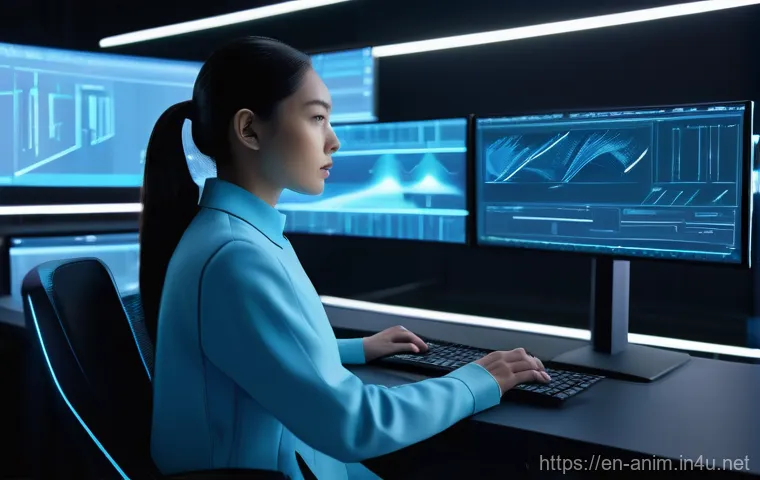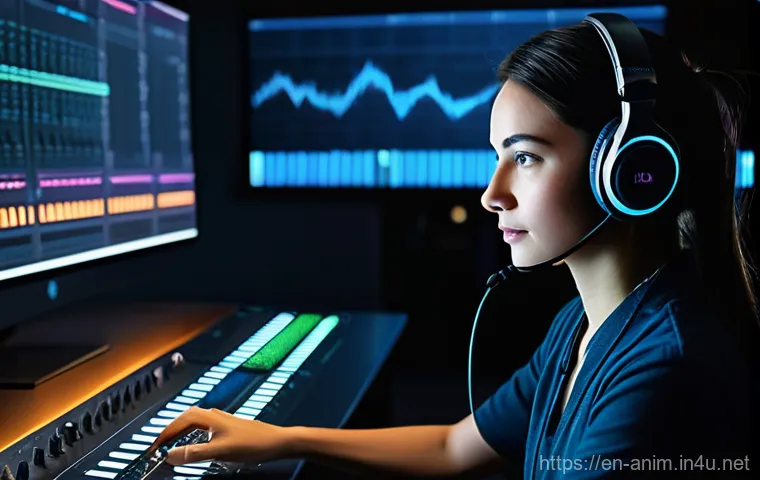Hey everyone! If you’re anything like me, you’ve probably been watching the animation industry lately and just felt completely energized by how fast things are moving.
It’s truly incredible to see our world evolve, isn’t it? From the buzz around AI automating those super time-consuming tasks like in-betweening and rigging – seriously, how much more creative freedom does that give artists?
– to the breathtaking leaps in real-time rendering that are practically blurring the lines between concept and final vision, it feels like we’re living in a golden age of innovation.
But let’s be real for a sec. While these advancements promise a future filled with hyper-realistic 3D worlds and immersive AR/VR experiences, they also heap a ton of new complexities onto our plates.
I’ve seen firsthand how studios, big and small, grapple with the pressure of tight deadlines and the sheer effort it takes to stay current with ever-evolving technologies and sustainable practices.
And don’t even get me started on managing remote teams across different time zones while maintaining that crucial creative synergy – it’s a genuine challenge!
That’s why having a rock-solid production checklist isn’t just a nice-to-have; it’s absolutely essential for staying sane, on budget, and delivering those jaw-dropping animated masterpieces.
It’s about building a robust foundation so your team can navigate these dynamic waters, ensuring every stage, from concept to final pixel, is handled with precision.
Ready to cut through the noise and streamline your animation projects like a pro? We’re going to accurately break it all down for you!
Getting Your Creative Ducks in a Row: The Pre-Production Deep Dive

Crafting a Vision That Sings
When you kick off any animation project, it’s incredibly easy to get swept up in the excitement of new ideas, but trust me, taking the time to truly solidify your vision upfront is a monumental game-changer.
I’ve personally been there, diving headfirst into character designs or storyboards without a crystal-clear understanding of the core message, and it *always* leads to painful, costly revisions down the line.
It’s truly like trying to build a beautiful skyscraper without a solid blueprint – you might get walls up, but they won’t stand for long, and the whole thing could come crumbling down!
This foundational stage is all about asking the tough, probing questions: What’s the emotional heartbeat of this story? Who exactly are we trying to reach with our narrative?
What specific feeling or message do we want to evoke in our audience? When you can articulate these answers with unwavering conviction and clarity, everything else within the production pipeline falls into place with remarkable smoothness.
We’re talking about developing a rock-solid script that resonates, detailed concept art that captures the exact mood and aesthetic perfectly, and character bibles that breathe unique, vibrant life into your creations long before a single frame is animated.
It’s the essential foundation upon which your entire project will either soar to incredible heights or stumble dramatically, and from my own extensive experience, rushing this paramount part is an absolute recipe for disaster.
Investing heavily here saves you countless headaches, precious hours, and ultimately, a significant amount of budget in the later, more costly stages.
Think of it like painting a true masterpiece – you wouldn’t just dive in with a brush without knowing your subject or your carefully selected palette, would you?
The Blueprint: Storyboarding and Animatic Magic
After the overarching vision is meticulously locked in and agreed upon, the next truly crucial step is transforming those brilliant, nascent ideas into a tangible, visual roadmap that everyone can understand and follow.
For me, storyboarding isn’t merely about sketching individual scenes; it’s an intuitive process of finding the natural rhythm, dynamic flow, and precise pacing of your animation.
I vividly recall one particular project where we were convinced we had a fantastic scene on paper, a real showstopper, but when we painstakingly put it into an animatic, the timing felt completely off, and a key emotional beat just didn’t land with the impact we desired.
That early, insightful realization was a project-saver, literally preventing us from wasting weeks of intensive animation work! An animatic, for those who haven’t yet dipped their creative toes in this vital stage, is essentially a moving storyboard augmented with temporary audio and voiceovers.
It’s your very first, exciting chance to witness your story unfold in genuine motion, allowing you to catch awkward camera angles, clunky, jarring transitions, or even subtle dialogue issues before they become deeply embedded, expensive problems.
It’s an inherently iterative process, and you absolutely shouldn’t be afraid to tweak, re-cut, or even completely overhaul entire sections here. This iterative approach fosters an incredible sense of creative freedom because you gain the confidence that you can experiment boldly without costing the farm or delaying the entire project significantly.
It truly puts the “pre” in “pre-production,” allowing you to refine your narrative and visual flow with surgical precision, ensuring that when the full production gears finally start grinding, you’re not just moving, you’re moving with purpose and in the unequivocally right direction.
It’s the magical point where the art of storytelling truly begins to take compelling visual form, revealing both the profound strengths and any potential weaknesses of your developing narrative.
Navigating the Production Maze: Keeping Momentum High
Asset Management: The Digital Library That Powers Your Project
Once pre-production triumphantly wraps, you’re officially diving headfirst into the deep end: full-blown production. And let me tell you, if your asset management isn’t meticulously dialed in and efficient, it can honestly feel like you’re swimming upstream with heavy ankle weights on, exhausting your entire team.
I’ve witnessed firsthand how quickly a project can devolve into utter chaos and utter frustration when artists can’t locate the absolute latest character model, or when multiple, conflicting versions of the same background are mysteriously floating around, causing massive confusion, costly rework, and frayed nerves.
My personal mantra in this phase is “organization is liberation.” Implementing a robust, intelligent Digital Asset Management (DAM) system isn’t just a fancy, intimidating tech phrase; it’s the beating heart of a truly smooth and efficient production pipeline.
This absolutely means having crystal-clear naming conventions that everyone adheres to, version control that actually works flawlessly (so you can effortlessly roll back to previous iterations without breaking a sweat or losing crucial work), and a centralized, universally accessible location where every single team member knows precisely where to find exactly what they need, every single time.
Imagine, if you will, a beautiful world where your character artist updates a model, and that perfectly updated model automatically propagates to the animators, riggers, and texture artists without anyone having to manually copy files around or send countless emails.
That’s the dream, isn’t it? It dramatically cuts down on frustrating back-and-forth communication, proactively prevents costly errors, and allows your incredibly talented team to focus wholeheartedly on the creative, inspiring work they truly love, rather than playing digital detective for hours on end.
This indispensable system also needs to be effortlessly accessible, especially for remote teams spread across different geographical locations, ensuring everyone, regardless of their physical location, is always working with the most current, accurate, and correct assets, fostering unparalleled consistency.
Smart Scheduling and Realistic Deadlines
Ah, deadlines. The perennial bane of every creative soul, yet absolutely essential for getting anything truly meaningful finished and out into the world.
What I’ve learned through countless projects and many late nights is that “smart scheduling” isn’t about frantically cramming as much as humanly possible into every single day; it’s profoundly about being brutally, refreshingly honest with yourself and your amazing team about what’s actually achievable within a given timeframe.
Over-optimistic, wildly unrealistic schedules are a direct highway to team burnout, rushed, subpar work, and ultimately, a compromised final product that simply doesn’t meet its full potential.
I distinctly recall working on a project where we severely, tragically underestimated the intricate rigging time required for a particularly complex character, and it threw our entire animation phase off by several frustrating weeks.
The devastating ripple effect across the entire pipeline was brutal and profoundly impactful. Now, I *always* advocate for building in generous buffer time, especially for tasks that tend to be inherently unpredictable or highly iterative, like intricate simulations, detailed texture painting, or final rendering.
Using powerful project management tools to break down complex tasks into smaller, more manageable chunks, assigning clear, unambiguous ownership, and visualizing progress (think intuitive Gantt charts or dynamic Kanban boards) helps everyone stay accountable, motivated, and crystal clear on their responsibilities.
Regular check-ins aren’t just for upper management; they’re a vital chance for the entire team to voice concerns, celebrate small, morale-boosting wins, and collaboratively problem-solve any emerging issues.
Remember, a sustainable, consistent pace beats a frantic, unsustainable sprint every single time, both for the uncompromising quality of your creative output and the invaluable well-being of your incredible, hardworking team.
The Tech Stack That Clicks: Tools and Workflows
Embracing Automation and AI’s Helping Hand
Let’s really dive into tech, because honestly, this is precisely where I’ve personally witnessed some of the most jaw-dropping leaps in efficiency and creative enablement within the animation industry.
I used to be a bit of a traditionalist, I’ll admit, somewhat hesitant to fully embrace every shiny new tool that came along, but observing how elegantly and powerfully AI is transforming animation has completely, irrevocably shifted my entire perspective.
We’re certainly not talking about menacing robots taking over all aspects of creativity; we’re talking about intelligent, sophisticated tools handling the truly repetitive, often soul-crushing grunt work, thereby miraculously freeing up artists for what they do absolutely best: pure, unadulterated creation.
Tasks like in-betweening, meticulous motion capture cleanup, or even generating hyper-realistic crowd simulations can now be partially or even fully automated with incredible precision and speed.
I vividly remember a time when painstakingly painting out tracking markers was a notoriously soul-crushing, incredibly tedious task that devoured hours, but now, AI-powered tools make it almost instantaneous, a mere click away.
It’s genuinely like having an army of tireless, brilliant assistants working seamlessly alongside your talented team. The smart trick here is to astutely identify those repetitive, agonizingly time-consuming tasks within your existing pipeline that *could* be automated and then actively, proactively seek out cutting-edge software solutions or clever plugins that offer those precise capabilities.
It’s not just about dramatically saving time; it’s profoundly about reducing artist fatigue, preventing burnout, and allowing them to dedicate their precious, finite energy to crafting the nuanced performances and breathtaking visuals that truly elevate an animation project from good to extraordinary.
This isn’t just about achieving incredible speed; it’s about significantly increasing the creative ceiling and potential for everyone involved, pushing artistic boundaries further than ever before.
Seamless Integration: The Software Ecosystem
Having an incredibly powerful suite of individual tools is one thing entirely; making them all play nicely and harmoniously together is another significant challenge altogether.
I’ve personally experienced the sheer frustration of catastrophic data loss or critically corrupted files when desperately attempting to transfer assets between different, incompatible software packages because the entire pipeline wasn’t properly thought out or engineered from the outset.
It’s a guaranteed workflow killer, an absolute nightmare! The ultimate goal is to meticulously build a seamless, interconnected software ecosystem where assets and crucial data flow effortlessly and flawlessly from one stage of production to the next, without a single hitch.
This often critically means investing wisely in tools that boast strong, robust interoperability features, or, if you’re forced to work with disparate, less compatible software, ingeniously developing custom scripts or clever connectors to expertly bridge those workflow gaps.
For instance, ensuring your modeling software exports seamlessly and cleanly to your rigging software, which then feeds perfectly into your animation and final rendering packages, is absolutely paramount for a smooth production.
This isn’t just about technical finesse or wizardry; it’s profoundly about creating a smooth, uninterrupted, and inspiring creative flow for your immensely talented artists.
When they can intuitively move from initial concept to final, polished render without wrestling endlessly with incompatible file formats or clunky, cumbersome conversion processes, their productivity absolutely skyrockets, and so too does their job satisfaction and overall morale.
A well-integrated, thoughtfully designed pipeline acts precisely like a finely tuned orchestra, where every individual instrument instinctively knows its vital part and blends harmoniously and beautifully with the others to collectively create a stunning, cohesive symphony, a true masterpiece of animation.
| Workflow Challenge | Common Pitfall | Smart Solution / Best Practice |
|---|---|---|
| Asset Versioning | Multiple copies of assets, leading to confusion and errors. | Centralized DAM with automated version control and clear naming conventions. |
| Communication Gaps | Misunderstandings, rework due to unclear feedback. | Daily stand-ups, dedicated communication platforms, documented feedback loops. |
| Rendering Bottlenecks | Slow render times, delaying final delivery. | Leverage cloud rendering, optimize scene complexity, utilize GPU rendering where possible. |
| Scope Creep | Project grows beyond initial plan and budget. | Rigid adherence to approved pre-production documents, strict change order process. |
Keeping Everyone on the Same Page: Communication is King
Transparent Feedback Loops and Daily Scrums
In any truly collaborative creative endeavor, and especially within the intricate, multifaceted world of animation, communication is not just important; it can literally make or break an entire project.
I’ve learned this crucial lesson the hard way, through firsthand experience, that simply assuming everyone inherently knows what’s going on is a guaranteed recipe for disastrous misunderstandings, costly rework, and utterly wasted effort that saps morale.
That’s precisely why establishing transparent, consistent feedback loops is absolutely non-negotiable for a thriving animation studio. It’s not just about bluntly pointing out flaws or mistakes; it’s profoundly about delivering constructive criticism with unwavering clarity, genuine empathy, and deep respect for the artist’s work.
I’m a huge advocate for daily stand-ups or ‘scrums’ – even short, focused 15-minute virtual meetings – where every team member can briefly share what they passionately worked on yesterday, what exciting tasks they’re tackling today, and any specific roadblocks or challenges they’re currently facing.
This simple, consistent routine fosters an incredible sense of shared purpose, collective ownership, and proactive problem-solving that can prevent minor issues from snowballing.
It’s truly amazing how quickly a small, seemingly insignificant issue can escalate into a major problem if it’s not brought to light and addressed immediately.
I’ve witnessed teams get bogged down for days, even weeks, because one artist was silently struggling with a technical problem that another team member could have effortlessly solved in mere minutes.
Open channels for honest feedback, whether through dedicated review sessions, sophisticated annotation tools on shared assets, or even just a simple, intuitive chat system, ensure that everyone is perfectly aligned, informed, and empowered to contribute effectively and creatively.
It builds an invaluable foundation of trust and makes the entire team feel like a cohesive, synergistic unit, rather than a collection of isolated individuals working in disconnected silos.
Bridging the Gap: Remote Team Communication Strategies
The dynamic world of animation has embraced remote work with an unprecedented fervor, and while this flexibility offers incredible advantages, it also undeniably introduces unique, complex communication challenges that demand attention.
When you’re not physically in the same bustling room, those spontaneous hallway conversations, the quick desk-side chats, or the casual brainstorming sessions simply disappear, creating potential voids.
I’ve found that intentionally and thoughtfully building robust communication bridges for remote teams is absolutely crucial for maintaining creative synergy and preventing isolation.
This unequivocally means leveraging powerful video conferencing tools for regular face-to-face interactions, even if it’s just for a quick check-in or a brief creative discussion, as it genuinely helps maintain that vital human connection that fuels creativity.
Dedicated project communication platforms (think intuitive tools like Slack, Discord, or Microsoft Teams) with separate, clearly defined channels for different departments or specific projects keep discussions organized, easily searchable, and historically documented.
But beyond the mere tools, it’s profoundly about fostering a vibrant culture of proactive over-communication – not in an annoying, verbose way, but by encouraging team members to meticulously document decisions, proactively share progress updates without being asked, and ask questions freely and without hesitation.
One thing I absolutely swear by for effective remote reviews is utilizing screen-sharing tools with advanced annotation capabilities; it’s almost like being in the same room, pointing at the screen together, discussing the nuances of every frame.
This meticulous, thoughtful approach to communication minimizes costly misunderstandings across diverse time zones and ensures that even if you’re physically thousands of miles apart, your team feels genuinely connected, perfectly informed, and truly an integral part of something bigger and more inspiring than themselves.
From Pixels to Polish: The Post-Production Hustle

The Art of Compositing and Visual Effects Integration
Once your animation is looking stellar, truly hitting its stride, and all the character performances are flawlessly nailed down, you joyfully move into the magic phase: compositing and visual effects.
This is the exhilarating stage where all those disparate, meticulously crafted elements—the dynamic characters, the breathtaking backgrounds, the intricate lighting passes, and any dazzling special effects—finally come together in a breathtaking dance to form the final, cohesive, and utterly stunning image that will grace the screens.
I’ve personally found this particular stage incredibly rewarding and deeply satisfying because it’s precisely where you truly witness your entire vision coalesce into a tangible, beautiful reality.
A poorly composited shot, no matter how brilliant the underlying animation, can completely undermine the hard work, making it feel disjointed, unnatural, or undeniably artificial.
It’s an art form in itself, about blending everything seamlessly, ensuring consistent lighting across all elements, achieving perfect color grading, and integrating atmospheric effects that draw the viewer in.
Think about how a subtle, perfectly placed lens flare or a meticulously timed particle effect can dramatically enhance a scene’s emotional impact or cinematic grandeur.
This is also where you integrate any complex visual effects, ranging from realistic dynamic simulations like fire, smoke, and water to intricate, ethereal magical spells that defy reality.
It demands an incredibly meticulous eye for the finest details and a deep, intuitive understanding of how light, shadow, and color interact in a believable way.
The ultimate goal here isn’t just to make things *look* pretty or aesthetically pleasing; it’s to profoundly enhance the storytelling, to draw the viewer deeper into your meticulously crafted world, and to add that final, exquisite layer of polish that truly elevates your animation to a professional, industry-leading, high-quality standard.
It’s the stage where unparalleled technical expertise truly merges with a profound artistic sensibility to create something truly breathtaking, something that resonates deeply with the audience.
Sound Design and Music: The Unsung Heroes
You might possess the most visually stunning, emotionally resonant animation imaginable, but without stellar, evocative sound design and a captivating, unforgettable musical score, it can unfortunately fall completely flat, losing much of its potential impact.
Trust me implicitly on this; I once watched an animatic with only placeholder sound effects and a temporary music track, and it was an absolute night and day difference compared to the final, polished version with professional, bespoke audio.
Sound isn’t just an add-on or a mere afterthought; it’s an integral, foundational part of the complete storytelling experience, intrinsically capable of evoking powerful emotions, establishing immersive atmosphere, and subtly guiding the audience’s attention and focus within a scene.
Think about the satisfying *thwack* of a perfectly timed punch, the subtle, gentle rustle of leaves in a quiet forest, or the tense, creeping silence that precedes a terrifying jump scare.
These auditory cues are just as powerful and impactful as your meticulously crafted visuals, often working hand-in-hand to create a holistic experience.
And music? Music is pure, unfiltered emotion. A brilliant, expertly crafted score can elevate a seemingly mundane scene into an epic, unforgettable moment, or add a profound layer of melancholy and introspection that resonates deeply within the viewer’s soul.
Collaborating closely and extensively with talented sound designers and composers from the early stages of pre-production, sharing animatics, and engaging in deep discussions about the emotional beats of each scene ensures that the audio perfectly complements and enhances your visuals, creating a unified artistic statement.
Don’t ever underestimate the transformative power of sound to fully immerse your audience; it’s truly the unsung hero that often takes your animation from “good” to “unforgettable,” leaving a lasting, powerful impression long after the credits have rolled and the screen fades to black.
Budgeting Like a Boss: Making Every Penny Count
Realistic Financial Planning from Day One
Let’s face it honestly, animation is expensive. There, I said it out loud! And one of the biggest, most common pitfalls I’ve seen countless studios tumble into is the trap of wildly unrealistic financial planning right at the very start of a project.
It’s undeniably exciting to dream big, to envision grand cinematic spectacles, but those magnificent dreams absolutely need to be grounded in solid, meticulously crunched numbers and a dose of reality.
I’ve personally been an active part of numerous projects that started with the most grand, expansive ambitions, only to realize halfway through that the allocated budget simply couldn’t stretch that far, leading to incredibly painful compromises, heartbreaking cuts, and even, in some unfortunate cases, outright cancellations that devastate morale.
The absolute key here is to meticulously break down every single conceivable cost: every salary, every single software license, all necessary hardware upgrades, critical rendering farm time, bespoke music composition, intricate sound design, essential marketing efforts – literally everything imaginable that will incur an expense.
And then, here’s the crucial part: *always*, without fail, add a substantial contingency fund! Seriously, I cannot stress this enough; always build in a buffer (I usually aim for a robust 15-20% of the total budget).
Unexpected issues *will* undoubtedly arise, whether it’s a critical software bug that delays production for days or an unforeseen need for additional voice acting sessions.
Having that financial buffer prevents panic, provides essential flexibility, and allows you to proactively address problems without completely derailing the entire project’s timeline or creative vision.
Being transparent with your dedicated team about the cold, hard financial realities also helps foster a vital sense of shared responsibility and genuinely encourages creative problem-solving within those predefined budgetary constraints.
It’s not about stifling or limiting artistic creativity; it’s profoundly about enabling it responsibly and sustainably, ensuring the project can actually be completed.
Smart Resource Allocation and Cost-Saving Strategies
Once you have your meticulously planned budget firmly in hand, the next significant challenge is intelligently allocating those precious resources wisely and proactively finding smart, innovative ways to save without ever compromising the uncompromising quality of your animation.
This often necessitates making tough, strategic decisions that might not be popular but are ultimately vital for the project’s success. For instance, do you truly need custom-designed models for every single background extra in a crowd scene, or can you judiciously utilize a library of high-quality pre-made assets or clever procedural generation techniques for efficient crowd simulations?
I’ve personally witnessed projects save truly significant amounts of capital by diligently optimizing rendering pipelines, strategically utilizing cloud rendering solutions during off-peak hours to reduce costs, or intelligently exploring robust open-source software alternatives where appropriate and effective.
Another massive area for substantial savings is through undeniably efficient workflows. Remember how passionately I talked about meticulous asset management and embracing smart automation?
Every single hour saved through streamlined, optimized processes is an hour not spent paying incredibly talented artists for redundant, time-consuming work.
Consider strategically outsourcing specific, specialized tasks like rotoscoping, detailed cleanup work, or intricate motion tracking to specialized studios if it proves to be more cost-effective and efficient than keeping it all in-house.
It’s profoundly about being consistently strategic and analytical. Continuously evaluating exactly where your money is flowing and constantly asking yourself, “Is there a more efficient, smarter, or more innovative way to achieve this outcome without sacrificing even an iota of the artistic integrity of our creative vision?” is a practice that can literally save your project from financial ruin and miraculously allow you to invest more capital where it truly matters most, ultimately elevating the overall quality and impact of your animation.
Learning from the Rushes: Iteration and Feedback Loops
The Power of Iteration: Embrace the “Ugly First Draft”
No animation project, no matter how brilliantly or perfectly planned down to the last pixel, ever comes out exactly as envisioned on the very first try.
And you know what? That’s perfectly, absolutely okay! What I’ve learned from countless years immersed in this incredibly dynamic industry is the immense, transformative power of iteration.
Seriously, embrace the “ugly first draft” mentality with open arms. I used to be so incredibly attached to my initial ideas, rigidly believing they absolutely had to be perfect right out of the gate, but that inflexible mindset completely stifled my creativity and dramatically slowed down the entire production process.
Now, I wholeheartedly encourage getting something, anything, down quickly, even if it’s incredibly rough or unpolished, because it immediately provides you with something tangible, something real to react to, to critique, and to improve upon.
It’s infinitely easier, faster, and more creatively fulfilling to refine an existing piece of animation, a character design, or a story beat than to stare endlessly at a terrifyingly blank screen, anxiously hoping for a spontaneous flash of perfection.
This powerful approach means meticulously scheduling dedicated time for review and revision cycles at every single stage of production, not just at the very end.
Don’t ever wait until the eleventh hour to finally show your work. Regular “dailies” or “rushes” sessions, where the entire team collaboratively reviews recent work, are utterly invaluable.
These sessions aren’t about harsh judgment or criticism; they’re profoundly about collaborative problem-solving and collectively finding the absolute best version of your shared creative vision together.
The more you iterate, the more you refine, and the closer you get to that truly polished, impactful, and unforgettable final product. It’s a continuous, exhilarating journey of improvement, and it’s absolutely thrilling to witness the remarkable transformation unfold before your very eyes.
Post-Mortem Magic: Learning for Future Success
Once your magnificent animation project is proudly out in the world, garnering well-deserved praise, touching hearts, and perhaps even collecting some prestigious awards (fingers enthusiastically crossed for you!), don’t just pack up your bags and immediately move on to the next exciting thing.
This is precisely where the real, profound, long-term growth and invaluable learning happen: through the often-underestimated post-mortem review. I’ve been in countless project wrap-up meetings that were nothing more than celebratory lunches, which are certainly nice and boost morale, but they tragically miss a colossal opportunity for growth and learning.
A true, insightful post-mortem involves thoughtfully sitting down with your entire dedicated team – everyone from the visionary concept artists to the meticulous compositors – and honestly, openly discussing what went incredibly well, what could have undeniably gone better, and, most importantly, what vital lessons were learned from the entire experience.
What specific processes worked brilliantly and smoothly? Where did we stumble, hit unexpected snags, or make critical missteps? What particular software gave us headaches and frustrations, and what tools or techniques truly saved our bacon and kept us on track?
I often find it incredibly helpful to conduct anonymous surveys to encourage truly candid and honest feedback, as sometimes people are understandably hesitant to speak up openly in a larger group setting.
Meticulously documenting these hard-won insights creates an invaluable, living knowledge base for all future projects. It’s truly like meticulously building a detailed treasure map for future success, helping you proactively avoid past mistakes and cleverly replicate brilliant, effective strategies.
This unwavering commitment to continuous learning and iterative improvement is what truly differentiates remarkably successful studios and individuals from those who merely drift along.
It ensures that every single project, regardless of its ultimate outcome, profoundly contributes to making the next one even stronger, smarter, more efficient, and ultimately, far more successful and creatively fulfilling.
Concluding Thoughts
And there you have it, a whirlwind tour through the fascinating, intricate world of animation production! It’s truly a journey filled with creative highs, inevitable challenges, and immense satisfaction as you watch your vision spring to life. Remember, every successful animation project, big or small, is built upon a foundation of meticulous planning, smart execution, open communication, and an unwavering commitment to continuous learning. It’s not just about the final dazzling frames; it’s about the purposeful process, the collaborative spirit, and the joy of crafting stories that resonate deeply with your audience.
Useful Information to Know
1. Master Pre-Production: Seriously, spend ample time here. A rock-solid script, detailed storyboards, and clear concept art will save you mountains of time and budget in later stages. It’s like laying the perfect foundation for a magnificent building.
2. Embrace Technology Wisely: Automation and AI aren’t here to replace artists; they’re powerful allies designed to handle repetitive tasks, freeing up your team for pure, unadulterated creativity. Find tools that integrate seamlessly into your workflow.
3. Communication is Your Superpower: Whether it’s daily stand-ups, transparent feedback sessions, or robust tools for remote teams, clear and consistent communication prevents misunderstandings, fosters collaboration, and keeps everyone aligned.
4. Budget with Buffers: Always, *always* include a contingency fund (15-20% is a good starting point) in your financial planning. Unexpected issues are a given in any complex project, and this buffer is your safety net.
5. Learn from Every Project: Conduct thorough post-mortems after each project. Document what went well and what didn’t. This invaluable knowledge base is crucial for refining your processes and ensuring future successes.
Key Takeaways
Navigating the animation production landscape requires a blend of artistic vision, technical prowess, and astute management. Prioritize a clear pre-production vision, manage your assets and schedules intelligently, and leverage technology, including automation, to enhance efficiency. Foster an environment of open, transparent communication, especially with remote teams. Remember that sound design and music are just as vital as visuals in storytelling. Finally, always plan your finances realistically, including contingency funds, and embrace iteration and post-mortem reviews to continuously refine your craft and achieve sustainable success.
Frequently Asked Questions (FAQ) 📖
Q: Okay, so with all the talk about
A: I automating tasks like in-betweening, does that mean traditional production checklists are becoming, well, a bit outdated? A1: Oh, this is such a fantastic question, and one I hear a lot!
It’s totally understandable to wonder if AI makes old-school checklists obsolete, especially when you see how it’s speeding up things like in-betweening, rigging, and even generating initial concept art.
In my experience, it’s not about replacing the checklist, but rather evolving it. Think of it this way: AI is an incredible co-pilot, not the entire flight crew.
It handles a ton of the grunt work, freeing up artists to focus on the truly creative and nuanced aspects of animation. So, instead of checking off “manual frame-by-frame drawing” a million times, your updated checklist might include steps like “review AI-generated in-betweens for consistency and artistic intent” or “manage AI model training for character rigging.” It shifts the focus from purely manual execution to overseeing and refining AI outputs, ensuring they align with your creative vision.
For smaller studios, this is a game-changer because AI tools can level the playing field, giving them access to efficiencies previously only available to the giants.
It actually makes a well-structured checklist even more crucial because you’re now managing a blend of human and AI contributions, which requires clear processes for integration, quality control, and ethical considerations.
Trust me, I’ve seen projects go sideways when teams just assumed AI would handle everything without proper oversight!
Q: I totally get that deadlines are a nightmare. But honestly, how can spending more time creating and following a checklist actually help us meet them faster, instead of just feeling like extra work?
A: You’ve hit on a common pain point, and I completely empathize! It often feels counter-intuitive to spend time planning when the clock is ticking, right?
But here’s the secret sauce I’ve personally discovered: a robust checklist isn’t “more work”; it’s a massive time-saver and stress-reducer in disguise.
Imagine building a house without a blueprint – you’d hit snags, rework things constantly, and probably go way over budget and schedule. An animation production checklist is exactly that blueprint for your project.
By outlining every single step, from concept to final render, and assigning clear responsibilities and deadlines, you drastically reduce miscommunication, rework, and forgotten tasks.
It’s like magic, but it’s just good planning! I’ve seen studios slash their production time by preventing costly errors that inevitably pop up when things are haphazard.
When everyone knows their role and the sequence of tasks, the workflow becomes incredibly smooth. For example, a checklist ensures all necessary assets are ready before animators need them, avoiding frustrating delays.
It’s about proactively managing potential roadblocks so you can actually accelerate through your project, keeping quality high and your sanity intact.
It provides that stability and foresight that keeps those financial hiccups and creative revisions from spiraling out of control.
Q: My team is spread out, some in L
A: , some in London, some working from home in their PJs. How can one checklist possibly tie us all together and keep our creative mojo going strong? A3: Oh, the distributed team dilemma!
This is a challenge I’ve tackled firsthand, and let me tell you, a well-implemented checklist becomes your team’s digital glue. When you can’t just lean over and chat with a colleague, clear, accessible documentation is absolutely paramount.
A production checklist provides a standardized roadmap that everyone, no matter their timezone or location, can refer to. It’s not just about tasks; it’s about shared understanding.
My best advice? Use your checklist to define communication protocols (which tool for what purpose!), set clear expectations for deliverables, and even outline specific check-in times that accommodate different schedules.
For instance, a daily stand-up might happen at a time that works for most, with summaries posted for those in different zones. The checklist makes sure everyone is on the same page regarding the project’s goals, milestones, and individual responsibilities, minimizing misunderstandings and fostering trust.
It builds that transparent environment where creative feedback loops remain tight, even when you’re thousands of miles apart. Plus, having everything documented centrally means new team members can get up to speed much faster, ensuring that “creative mojo” isn’t just a fleeting feeling but a sustained, collaborative effort.






